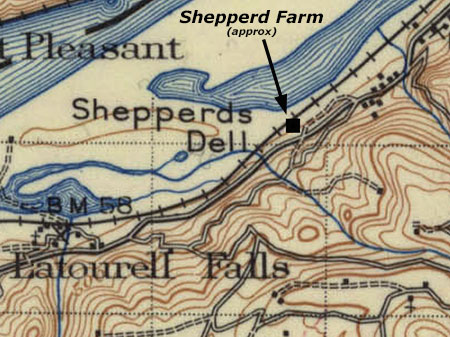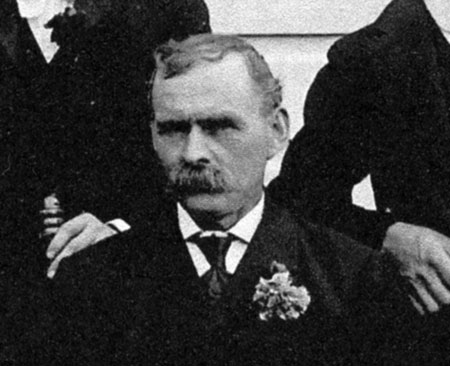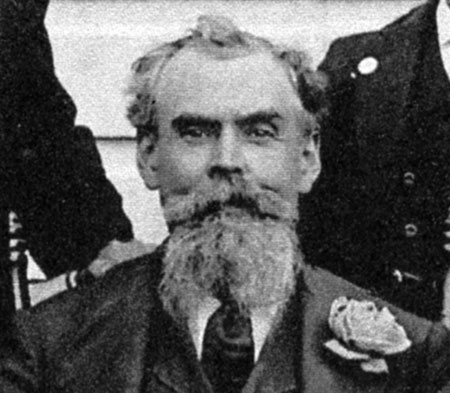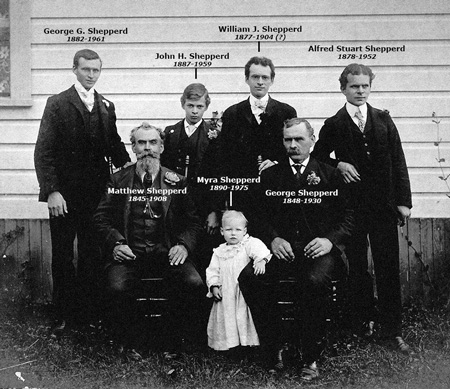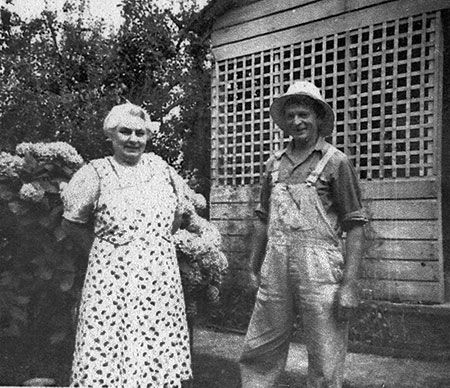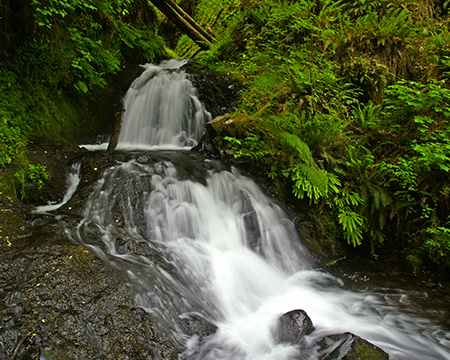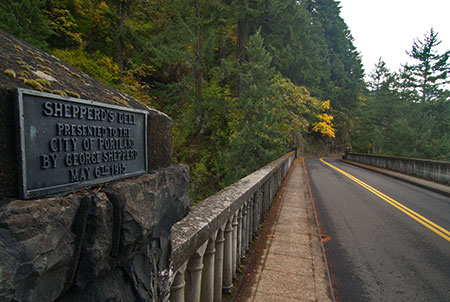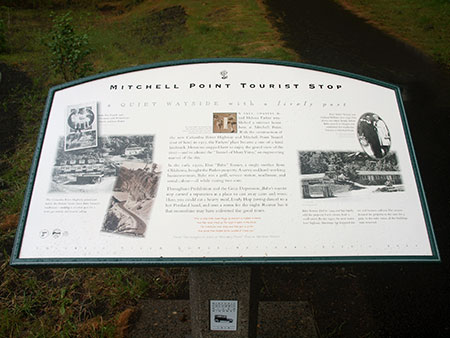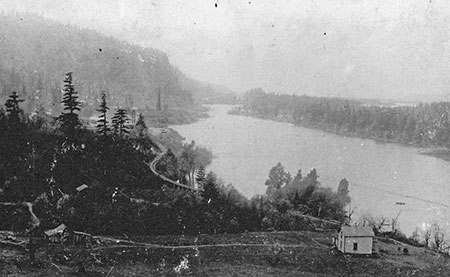
1890s view of George Shepperd’s farm on the Columbia, located just east of Shepperd’s Dell (Photo courtesy Rosemary Guttridge)
George Shepperd’s place in our history comes from his generous donation of Shepperd’s Dell to the public in 1915, as the historic Columbia River Highway was nearing completion.
After posting the story of George Shepperd recently in “The Farmer and his Dell” , his great-great granddaughter Rosemary (Shepperd) Guttridge contacted me with a few updates to the article and some wonderful photographs. This follow-up article includes several of her Shepperd family photographs and a brief interview with Rosemary Guttridge — and a proposal for finally honoring George Shepperd at his namesake dell in the Columbia River Gorge.
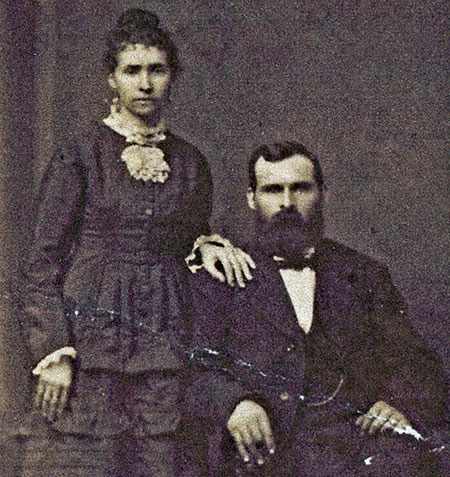
George and Matilda Shepperd (his first wife) in roughly the 1870s (Photo courtesy Rosemary Guttridge)
The first of the family photos provided by Rosemary Guttridge (above) shows a very young George Shepperd with his first wife, Matilda. This undated photo is likely from the 1870s, when Shepperd was still in his mid-20s and before the couple moved their young family to Iowa. They would farm for a decade on the open prairie before finally heading west to Oregon.
The second image (below) shows the humble farmhouse on the prairie where George and Matilda’s lived through the 1880s, and where their family grew to include four young sons: William, Stuart, George G. and John. A close look at this image shows Matilda standing in the foreground with two of the boys:
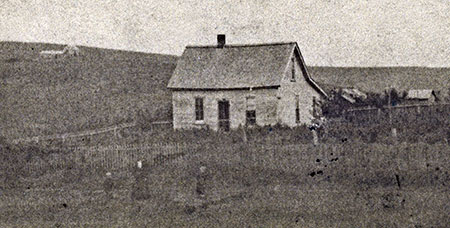
George and Matilda Shepperd’s farm on the Iowa prairie in the 1880s (Photo courtesy Rosemary Guttridge)
In 1889, the Shepperds moved west to Oregon, claiming a few parcels of land at the mouth of Young Creek, just west of the sawmill at Bridal Veil. In the 1912-vintage map, below, the approximate location of the Shepperd farmhouse is shown:
This is a rough guess of the location based on images of the farm showing Crown Point in the distance, a flooded Columbia River and the first rail line to be constructed on the Oregon side of the Gorge. The cluster of buildings shown to the east on this map are part of the mill town of Bridal Veil, and located on the site of today’s Bridal Veil State Park.
The following is an enlarged view from the image in the top of the article focusing on the Shepperd farmhouse. Power poles mark the railroad (directly behind and below the house) and there is even a rowboat on the river:
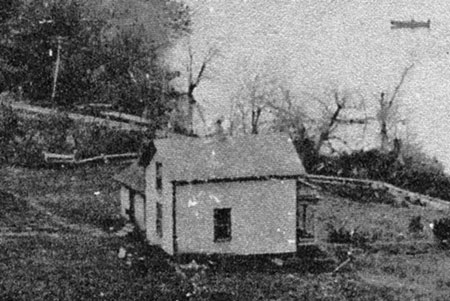
Enlarged view of the Shepperd farm house – note the rowboat in the background and railroad tracks immediately below the house (Photo courtesy Rosemary Guttridge)
The above image shows the area around the house to be a bit barren, and the Shepperd family history dates this photo to 1898, roughly nine years after George and Matilda Shepperd claimed the land. For a larger view of the farm photo (including Crown Point on the horizon) click here.
The most stunning and fascinating of the images shared by Rosemary Guttridge is the following family portrait, taken in approximately 1895, based on the ages of the family members. The photo tells a story of change in the family, as it was taken in the period after George and Matilda Shepperd had divorced in 1895, but before George had remarried to Mattie Williams in January 1896.
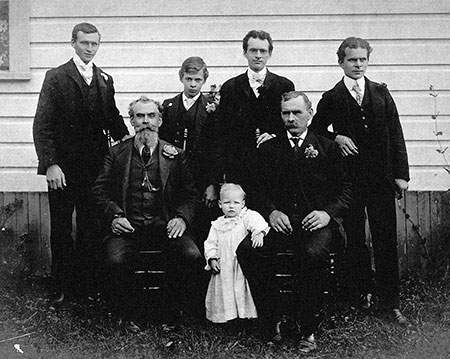
George Shepperd’s family in about 1892, shortly after he and Matilda had divorced (Photo courtesy Rosemary Guttridge)
The family portrait provides our first good look at George Shepperd, 46 years old in this photo, and also a man to his right who seems to be his older brother by three years, Matthew Shepperd. Matthew shows up as living at the Shepperd farm in the 1900 census, so one possibility is that he arrived to help George with the farm and raising his children after George and Matilda divorced.
A highlight of the family photo is little Myra Shepperd (below), just five years old in 1895, and striking a brave pose as the lone daughter in a house full of men and young boys:
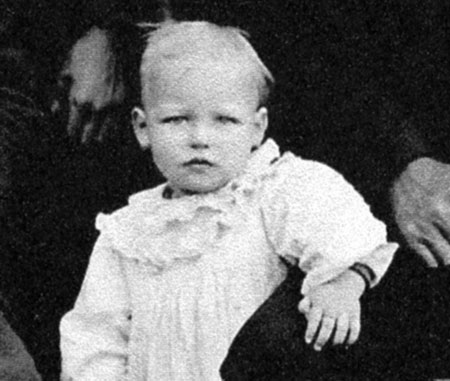
Baby Myra Shepperd, youngest of George and Matilda’s children and their only daughter (Photo courtesy Rosemary Guttridge)
Despite this challenging start, Myra went on to marry Robert Earley when she was 18 (in 1908), and they had two children of their own. Myra lived until 1975, when she died at the age of 85.
The identity of the three older sons in the family photo is somewhat confusing, but Rosemary Guttridge is certain that her grandfather, George G. Shepperd, is standing on the far left (tallest of the three boys). Though he looks older than his years in this photo, he would have been just thirteen.
[click here for a larger version of the annotated photo]
Rosemary Guttridge shared another portrait of her grandfather, George G. Shepperd, taken in 1902 (below) when he was 20 years old. George G. would marry Emma Fick in 1914, and the couple moved to the Shepperd farm in 1920, after his father had retired to Portland. George and Emma farmed and raised dairy cattle on the farm until 1953 or 1954.

George G. Shepperd, third son of George Shepperd and Rosemary Guttridge’s grandfather at the age of 20 in 1902 (Photo courtesy Rosemary Guttridge)
George G. Shepperd’s son (and Rosemary Guttridge’s father) was George Shepperd Jr. (known simply as “Junior” in the Shepperd Family). He spent much of his childhood at the Shepperd farm in the 1920s and 30s, and married Suzanne Curtis in 1940. Their very young children George Scott and Rosemary visited the family farm before their grandparents moved to Portland in the early 1950s.
George Junior died in 1975 but his wife Suzanne has survived him by nearly four decades, and is still living today in the Gresham area at age 97.
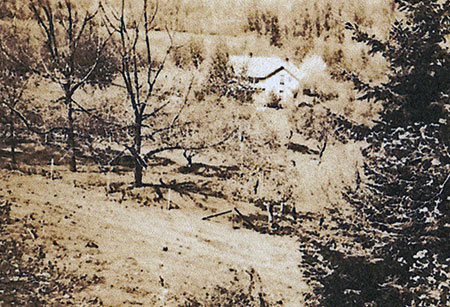
George Shepperd’s farmhouse some years after the first photo was taken, perhaps in the early 1900s (Photo courtesy Rosemary Guttridge)
Rosemary Guttridge shared another photo (above) of the Shepperd farm that is dated 1898, but seems to be taken much later than the earlier photo (at the top of the article), judging by the size of the established trees in this photo. Assuming the first photo was taken in the 1890s, this photo is likely to be from sometime in the early 1900s.
In early April 2014, I interviewed Rosemary (Shepperd) Guttridge to gain her personal insight into the legacy of George Shepperd and life at Shepperd’s Dell:
_______________
WyEast Blog: Rosemary, thanks for answering a few questions about your family — the Shepperds of beautiful Shepperd’s Dell! George Shepperd was your great-grandfather, but I don’t think he was alive when you were born, is that right?
He died in 1930 when my dad would have been 15 years old.
From the scant records I have, my grandparents, George G. and Emma Shepperd moved out to the family farm at Shepperd’s Dell from Beaverton in 1920. The must have lived with my grandmother’s family there. And I’m not sure if my great-grandfather moved to Portland at that time [editor’s note: the Oregon Journal obituary for George Shepperd suggests that he moved to Portland in about 1912]
WyEast Blog: So, your grandfather is George G. Shepperd, the third son of George Shepperd — and your father is George Shepperd, Jr., is that right? From the family history you shared with me, there are George Shepperds in the family line that date back to England in the 1700s – that’s a lot of George Shepperds to keep straight!
There are certainly many Georges in the family tree and unfortunately they didn’t seem to use middle names often so it is a bit hard to keep them straight.
The first recorded George Shepperd (in our family Bible) was born sometime in the late 1780s and his son was James, who was my great-grandfather’s father. Now we’re back to Georges! Great-grandfather George was born in 1848, his son, my grandfather George G., was born in 1881 and his son, my father George (known as Junior in school), was born in 1915.
Wouldn’t want to stop there!! My brother, George Scott is one more. And I realized my mother’s grandfather is George. Then after my father passed away, my mother married… yep, another George!!
I think the family is done with that name for now!
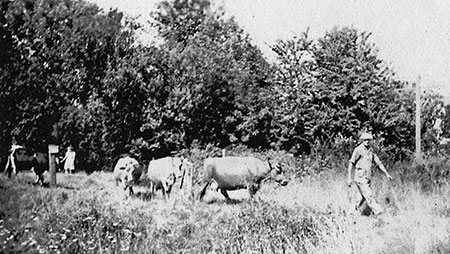
The Shepperd farm in the 1940s when George G. and Emma Shepperd were raising dairy cattle there (Photo courtesy Rosemary Guttridge)
WyEast Blog: Your grandparents lived on the family farm at Shepperd’s Dell until sometime in the 1950s. Do you have memories of them from the farm?
My only memory was when I was probably 3 or 4 years old trying to feed the cows some grass. I reached through the barbed wire fence with handful of grass and caught my arm. The scar is still quite visible.
I don’t remember anything about the inside of the farmhouse, the barns or the views. My brother says he remembers staying overnight at the farm and he had to sleep upstairs with no heat or lights and it was “scary”.
My grandmother mentioned more than once the hobos who would come [to the house] for a meal. She said [the family] had left some kind of mark on the gate, which meant they could stop.
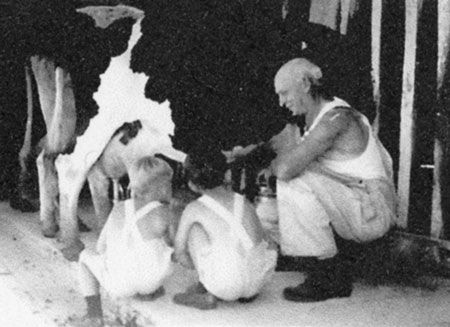
George G. Shepperd and a couple of young helpers on the Shepperd Farm in the 1940s (Photo courtesy Rosemary Guttridge)
WyEast Blog: You also sent a wonderful photo of the Shepperd land claim, with the Columbia River and Crown Point as the backdrop – what a beautiful place to have a farm! But it must have been a hard life living through the harsh winters the Gorge is known for — is that something that has been passed down in your family history?
My grandfather was a dairy farmer, which must have been so very tough in the winters. Not sure how they even got the milk to town.
My father left the farm after some college and became a banker. Not sure he thought diary farming was much fun!
WyEast Blog: The photo of the Shepperd farm shows at least three buildings – a farmhouse and at least two barns. Is this the same farmhouse that your grandparents later lived in? Does it survive today?
There is nothing left of the old farmhouse or barn. Now, in its place is a rambling one-story house.
I’m not even sure what happened to the place after Grandpa and Grandma moved to Portland in 1953 or 1954. Hopefully some other relatives can read this and help out with what they know.
WyEast Blog: George Shepperd’s second wife, Mattie, died in 1903, just a few years after they were married and was buried at the Bridal Veil Cemetery. George placed a remarkable grave marker there — is there any family history about their short marriage? George was clearly heartbroken by her death, based on the inscriptions on her memorial.
Wish I knew something about this. And again, perhaps some relatives will surface and help!
WyEast Blog: You’ve undoubtedly visited Shepperd’s Dell many times in your life, and that must be an amazing feeling, to know that your great-grandfather made that park possible. Do you still visit Shepperd’s Dell, and what is it like for you to see the sign with your family name on it?
The Dell is very special and beautiful. I have a room in my house that is dedicated to any pictures or painting I can find of the area. I haven’t found anything new for quite some time, but I still look when I come to the west side of Oregon. I had wanted to get married on the platform down the path from the highway but it could not fit very many people so had to make other plans
WyEast Blog: Thanks for your help in piecing together a bit more of George Shepperd’s story, Rosemary – very much appreciated! Any other thoughts you’d like to share for this interview?
Again, I hope some of the relatives will read this and contact you with more information. I think some of them live in the Portland area. Wouldn’t it be great to get more pictures and to clear up so many of the questions!
WyEast Blog: Well, I will certainly let you know if I do hear from other relatives, Rosemary! Thanks, again, for tending to your family history, and especially the legacy of your great-grandfather.
_____________________
Special thanks go out to Rosemary (Shepperd) Guttridge for sharing so much of her family history. Rosemary has also given me permission to post a companion Wikipedia article on George Shepperd, including some of the family photos. I’ll post an update on this blog when the Wikipedia page is complete.
_____________________
Postscript: Telling the Story
The story of George Shepperd is inspiring on so many levels, and yet has been nearly forgotten in our written history of the Columbia River Gorge. His story deserves to be told to all who visit his Dell, and who might wonder about the mysterious name on the bronze plaque at the east end of the Shepperd’s Dell bridge.
Perhaps the most compelling reason to tell George Shepperd’s story is that he was one of us: a man of modest means who faced real hardships and tragedy in his life. He was different from the well-known timber barons and political icons whose names are engraved on monuments throughout the Columbia River Gorge. This distinction is important, as it inspires all of us to rise above our own everyday struggles, and strive for lasting contributions that will define us after we’re gone.
“Do you not know that a man is not dead while his name is still spoken?”
– Terry Pratchett
In this spirit, we should seize upon an opportunity in the form of a new Oregon State Parks plan for the Gorge that calls for renovating the Shepperd’s Dell wayside. The time is perfect to do justice to the memory of George Shepperd.
Two memorials are in order: one describing the history of the place, including the Shepperd farm, the donation of Shepperd’s Dell and the construction of the iconic bridge that spans the Dell. This part of the story could be told at the existing wayside, using this familiar interpretive sign format found in other refurbished park sites in the Gorge:
The second memorial should be to George Shepperd, the man. This memorial has already been written: when he died at the age of 82 in July 1930, the Oregon Journal printed a poignant tribute that still serves as a most eloquent salute to George Shepperd.
In remembering him, this tribute should be engraved for the ages (in bronze) and placed at the peaceful waterfall overlook at the end of the Shepperd’s Dell footpath, where visitors could reflect upon his gift to us — as we are “His Heirs”:
You can learn more and comment on the Oregon State Parks early plans for Shepperd’s Dell (and other state parks in the Gorge) on their Gorge Parks Plan website. While you’re there, consider putting in a good word for the legacy and memory of George Shepperd – as his fortunate heirs, it’s the least we can do!
